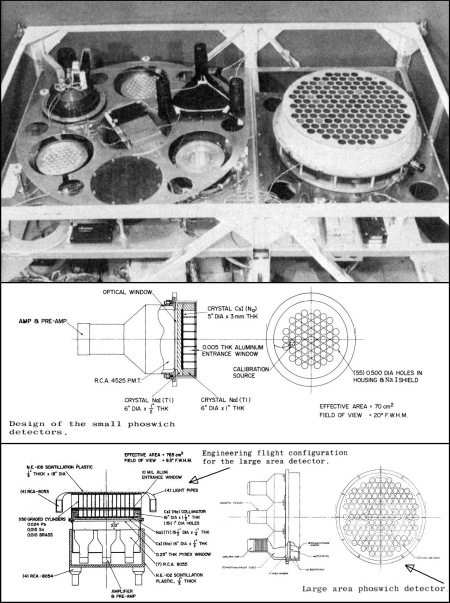Purpose of the flight and payload description
The objective of the flight was to study the performance of several phoswich designs for X-ray and gamma-ray detectors optimized for observations in the spectrum between 15 and 200 keV. Two of the detectors were of essentially identical design, except the central crystal-shield crystal materials were interchanged in order to study the optimum crystal configuration. The third detector was a large area unit of similar design. All three detectors were flown on an engineering balloon flight to study their performance in the cosmic-ray environment. The design and test of the detectors was in charge of the E. 0. Hulburt Center for Space Research of the Naval Research Laboratory from the United States Navy.
In the image at left we can see the distribution of the detectors in the flight gondola and below the designs of the three instruments (click to enlarge). The two small phoswich detectors are seen at the left of the gondola, positioned so that their apertures 'pointed' toward the zenith. A shutter assembly was utilized so that the detector apertures could be unobstructed, or could be blocked by either an active NaI(Tl) shutter, a plastic scintillator shutter or a passive shutter. The intrinsic detector background was measured with the NaI(Tl) shutter blocking the aperture, and in anticoincidence with the phoswich detector.
The primary X-ray detector (central crystal) consisted of a 3-mm thick by 5-inch. diameter CsI(Na) crystal. This was encapsulated between two 6-inch dia. NaI(Tl) crystals which provided the active shielding. The front NaI(Tl) crystal has 55 holes of 0,5 inch dia. drilled through it which acted as a collimator defining a 200 FWHM field-of-view. The rear NaI(Tl) crystal also served as a light pipe. The three crystals were optically coupled and viewed by a single 5-inch dia. photomultiplier tube.
The second small detector was of the same design except that the central crystal was NaI(Tl) and the shield crystal was CsI(Na).
The large area detector had a 15,5 inch dia. x 5-mm thick NaI(Tl) central crystal. The CsI(Na) collimator has 151 1-inch dia. holes drilled on 1 5/32-inch centers. This resulted in an effective area which was 63% of the total NaI(Tl) surface area. Seven 5-inch dia. phototubes viewed the crystal assembly. The effective area of this detector was 765 cm2.
The flight configuration for the large phoswich detector is shown at left (click to enlarge). The photomultiplier tubes were separated from the detector window by a 2-inch air gap to provide uniform response. External collimators, were co-aligned with each hole in the CsI collimator to reduce the field-of-view to 90 FWHM. The individual collimators consisted of graded lead, tin, and brass cylinders. A plastic anti-coincidence detector was used on top of the passive collimator to study background production in the graded shield by cosmic-ray interactions. Also, a plastic well detector surrounded the phototube assembly to investigate any background contribution due to direct cosmic-ray effects in the photomultiplier tubes.
Details of the balloon flight
Balloon launched on: 10/17/1973
Launch site: Columbia Scientific Balloon Facility, Palestine, Texas, US
Balloon launched by: National Scientific Balloon Facility (NSBF)
Balloon manufacturer/size/composition: Zero Pressure Balloon Winzen 329.044 m3 (12.70 Microns Stratofilm)
Flight identification number: 790P
End of flight (L for landing time, W for last contact, otherwise termination time): 10/17/1973
Balloon flight duration (F: time at float only, otherwise total flight time in d:days / h:hours or m:minutes - ): F 9 h 30 m
Payload weight: 505 kgs.
The balloon was launched from the National Scientific Balloon Facility in Palestine, Texas on October 17, 1973 at a time which enabled the sources Hercules X-1 and Cygnus X-1 to be viewed by the vertically oriented detectors. After a nominal ascent phase the balloon reached a float altitude of 133,000 ft. which was maintained for 9 hours and 30 minutes. The engineering tests on the phoswich detectors were very succesful. The inherent detector backgrounds were found to be very low. The Hercules transit provided a nul result, although this was expected since the Source was in an "off" state at the time. Cygnus X-1 was observed with a very good signal-to-noise ratio.
External references
- A balloon observation of the diffuse cosmic X-radiation above 20 keV Astrophysical Journal, Part 1, vol. 222, May 15, 1978, p. 370-378
- NaI/Tl/ - CsI/Na/ phoswich detectors for X-ray astronomy IEEE Transactions on Nuclear Science, vol. NS-22, Feb. 1975, p. 626-632
- National Scientific Balloon Facility Annual Report FY 1974 National Center for Atmospheric Research, December 1974
4485If you consider this website interesting or useful, you can help me to keep it up and running with a small donation to cover the operational costs. Just the equivalent of the price of a cup of coffee helps a lot.


